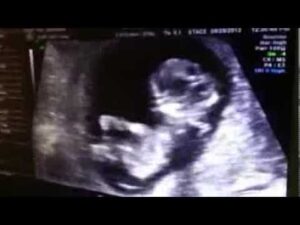
For would-be mothers, ultrasound scans are the highlight of the pregnancy. It is really exciting to “see” the baby in the womb, often moving their hands and legs.
Generally, having a scan in pregnancy is a happy event, but one should be aware that ultrasound scans may detect some serious abnormalities, so be prepared for that information as well.
What happens at the scan?
Usually, scans are carried out by sonographers (specially trained staff). The scan room may be dimly lit in order to provide the sonographer good images of your baby. First, you will be requested to lie on a couch, then you should lower your skirt or trousers to your hip level and raise your top to your chest. Then ultrasound gel will be applied on your tummy and tuck tissue paper around your clothing to protect it from the gel. The gel makes sure there is adequate contact between the machine and your skin.
A probe is passed over your skin. The probe sends ultrasound waves and picks them up when they bounce back. On doing this, a black and white picture of the baby will come on the ultrasound screen. Screens are kept in such a view to give sonographers a good view of the baby. The sonographer will closely examine the baby’s body. Though the scan does not hurt, the sonographer may need to apply a little pressure on your stomach to obtain best views of the baby.
Time taken for the scan
Normal time taken for the scan is around 20-30 minutes. However, the sonographer may not be able to produce good images if the baby is lying in an awkward position or moving around a lot. If you are overweight or your body tissue is dense, it is possible that the quality of the image is not good as there is more tissue for the ultrasound waves to get through before they reach the baby.
If good images are not coming by, the scan may take longer or has to be repeated at other time.
Is ultrasound scan safe?
There are no known health hazard for the baby or the mother from having an ultrasound scan.
When are scans offered?
Ideally, a minimum of three scans should be done during the course of the pregnancy.
The first scan is done during the early pregnancy (6–9 weeks) to confirm the location of the pregnancy, to find out whether it is a singleton/multiple pregnancy, to confirm the presence of fetal heart activity and to confirm the age of the pregnancy to allocate an estimated due date. This is called the ‘early pregnancy’ or the ‘dating’ or the ‘viability’ scan.
The next scan is done between 11 and 14 weeks, as by this time the baby is fully formed with a head, a body, two legs and two hands. Structural problems like improper development of the skull, limbs etc can be found out during this scan. This is a very important scan to assess the risk of chromosomal abnormalities like Down syndrome, in which mental retardation is a major component. This is called the “nuchal scan”.
The third scan is performed during 18 and 23 weeks. As the baby has become much bigger by now, structures like heart, kidneys, brain and facial features can be well visualized. The objective of the scan is to ensure normality of all these structures and diagnose if there is any problem. If an anomaly is detected, further investigations, follow-ups or counseling may be arranged as the case may be. This is called ‘routine anomaly scan’.
In a low-risk mother, these three scans are usually recommended. If there was an abnormality in a previous pregnancy or in the present one, further scans may be required. Some obstetricians request a ‘growth scan’ later in the pregnancy to make sure the baby is growing properly and the placenta is in its proper position.
It should be noted that there is no maximum number of scans that can be performed during a pregnancy. Clinical condition of the mother and the baby decide the number of scans.
Uses of ultrasound scans
An ultrasound scan can be used to check
• Your baby’s size – at the dating scan, this gives clear idea of how many weeks pregnant you are, the expected date of delivery, which is originally calculated from the first day of your last period.
• Check whether you are having more than one baby
• Detect some abnormalities
• Show the position of your baby and the placenta – for example, when the placenta is low down in late pregnancy, a caesarean section may be advised
• Check that the baby is growing normally – this is particularly important if you are carrying twins or you have had problems in this pregnancy or a previous pregnancy





